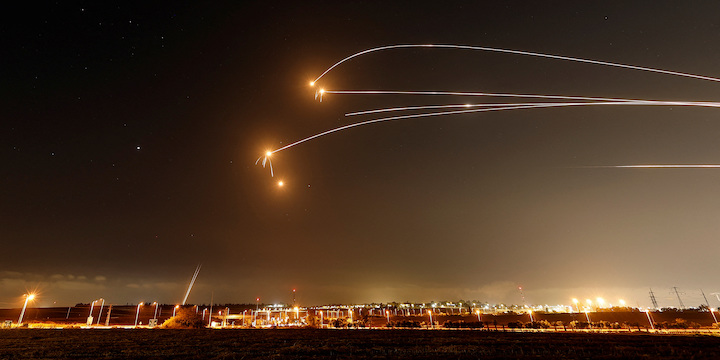 Zrzut ekranu z reportażu „Głosu Ameryki” o ludziach, którzy uciekli z Sudanu do obozów dla uchodźców w Czadzie przed trwającą wojną domową, 16 maja 2023 r. Źródło: Henry Wilkins/VOA via Wikimedia Commons.
Zrzut ekranu z reportażu „Głosu Ameryki” o ludziach, którzy uciekli z Sudanu do obozów dla uchodźców w Czadzie przed trwającą wojną domową, 16 maja 2023 r. Źródło: Henry Wilkins/VOA via Wikimedia Commons.
 Fałszywe ludobójstwo spotyka prawdziwe
Fałszywe ludobójstwo spotyka prawdziwe
Ben Cohen
Tłumaczenie: Małgorzata Koraszewska
Nie ma już wątpliwości, że społeczności żydowskie stoją w obliczu najgorszej fali antysemityzmu od czasów II wojny światowej. U podstaw obecnego ataku leży to, co moja koleżanka z JNS, Melanie Phillips, nazywa „palestynizmem”, który, jak twierdzi, „dąży do wykreślenia Żydów z ich kraju, ich historii i świata”. To wyjaśnia obsesję na punkcie przyklejania etykiety „ludobójstwa” do izraelskiej odpowiedzi militarnej na okrucieństwa z 7 października 2023 r., które same w sobie były aktem ludobójstwa, celowo wymierzonym w Żydów, ponieważ są Żydami żyjącymi w swojej historycznej ojczyźnie. Jednak w kontekście public relations musimy przyznać, że jest to stare oszczerstwo o rytuale krwi, tym, razem na sterydach, przyjęte nie tylko przez bezmyślne automaty w kefijach, ale także przez rządy od Irlandii po Republikę Południowej Afryki, a także przez Organizację Narodów Zjednoczonych, której sekretarz generalny, António Guterres, we wrześniu ubiegłego roku, ku swojej wiecznej hańbie, wyraził opinię, że „nigdy nie widział takiego poziomu śmierci i zniszczeń, jaki widzimy w Gazie w ciągu ostatnich kilku miesięcy”.
Ważne jest dostrzeżenie, że trauma, jakiej doświadczają Żydzi od 7 października, dotknęła również nie-Żydów. Nie mam na myśli naszych bezpośrednich sąsiadów w Europie i Ameryce Północnej, którzy, z wyjątkiem odważnej i głośnej mniejszości, podążyli za haniebną tradycją swoich przodków, odwracając wzrok. Mam na myśli te mniejszości i bezpaństwowe narody na całym świecie, których skarga na los z rąk represyjnych reżimów i ich zastępczych milicji została zagłuszona przez hałas tłumu popierającego Hamas i jego popleczników. Cisza i obojętność powitały krwawą obietnicę reżimu tureckiego „wyeliminowania” dowodzonych przez Kurdów, wspieranych przez USA sił oporu w Syrii po obaleniu nikczemnej dyktatury Baszara al-Assada. Ta sama Rada Praw Człowieka ONZ, która w zeszłym miesiącu ostro krytykowała Izrael, zorganizowała konferencję na temat „praw człowieka” z tą samą Komunistyczną Partią Chin, która dokonuje ludobójstwa w północno-zachodnim regionie Sinciang.
Jednak to trwająca rzeź w Sudanie naprawdę obnaża moralny rozkład w sercu „palestynizmu”. Po raz pierwszy odkąd termin „ludobójstwo” uzyskał status prawny wraz z przyjęciem w 1948 r. Konwencji ONZ o ludobójstwie, uwagę świata przykuło fałszywe ludobójstwo, podczas gdy w tym samym czasie szaleje prawdziwe. Za ten obrzydliwy wynik, który pozostawia niezatartą plamę na zachodniej cywilizacji, w dużej mierze należy podziękować propagandzie Hamasu, która żeruje na głupich i łatwowiernych umysłach w naszych własnych społeczeństwach.
Od wybuchu ostatniej wojny domowej w Sudanie w 2023 r. administracja Bidena umieściła tę kwestię na samym dole listy spraw do załatwienia w polityce zagranicznej. Jednak jednym z ostatnich działań ustępującego sekretarza stanu Antony’ego Blinkena było wydanie 7 stycznia oświadczenia, w którym stwierdzono, że „członkowie RSF i sprzymierzonych milicji dopuścili się ludobójstwa w Sudanie”. Za mało, za późno, z pewnością, ale nie całkowicie bezużytecznie.
Siły Szybkiego Wsparcia (RSF) to wytwór wzbudzających postrach paramilitarnych oddziałów Dżandżawid, które 20 lat temu dokonały ludobójstwa w zachodnim regionie Darfuru. Ostatnie walki rozpoczęły się w wyniku decyzji przywódcy RSF Mohameda Hamdana Dagalo, znanego jako „Hemedti”, o oddzieleniu się od rządu wojskowego, który przejął władzę w zamachu stanu w Chartumie w 2021 roku. Jak słusznie zauważył Blinken, zarówno reżim wojskowy, jak i RSF „ponoszą odpowiedzialność za przemoc i cierpienie w Sudanie i nie mają legitymacji do rządzenia przyszłym pokojowym Sudanem”. Ale RSF i jego sojusznicy, cytując ponownie Blinkena, „systematycznie mordowali mężczyzn i chłopców, a nawet niemowlęta, na tle etnicznym, a także celowo atakowali kobiety i dziewczęta z niektórych grup etnicznych gwałcąc i dokonując form brutalnej przemocy seksualnej”.
Całkowity koszt humanitarny jest niemal nie do pojęcia. Ponad 11 milionów ludzi zostało wewnętrznie przesiedlonych, a kolejne 3,1 miliona uciekło za granice Sudanu — około 30% populacji kraju. Prawie 640 tysięcy cierpi z powodu jednej z najgorszych klęsk głodowych w historii Sudanu. Ponad 30 milionów ludzi rozpaczliwie potrzebuje pomocy humanitarnej. Liczba ofiar śmiertelnych sięga dziesiątek tysięcy. Liczba demonstracji, wieców i protestów wynosi zero.
W pakiecie sankcji, które towarzyszyły oświadczeniu Blinkena, znalazło się siedem firm z siedzibą w Zjednoczonych Emiratach Arabskich — kraju, który jest sojusznikiem USA i partnerem w szerszym procesie pokojowym na Bliskim Wschodzie — które pomogły RSF kupować broń i przemycać złoto z dochodowych kopalni Sudanu przez Dubaj. ZEA prowadzi ambasadę i trzy konsulaty tutaj w Stanach Zjednoczonych, których adresy są łatwo dostępne po szybkim wyszukaniu online. Demonstracja przed jednym z nich pod hasłem „ZEA: Stop Funding Genocide in Sudan” byłaby całkowicie wykonalna i niezwykle godna pochwały. Ale organizacje, które mogłyby być w stanie zorganizować taką demonstrację — takie jak Black Lives Matter, co wyraźnie nie dotyczy życia czarnych w Afryce, gdy zabijają Arabowie — są nieobecne.
To sprowadza mnie z powrotem do punktu, który wcześniej poruszyłem: wpływu obecnego wzrostu antysemityzmu. Nigdy nie byłem zwolennikiem często powtarzanego twierdzenia, że Żydzi są kanarkiem w kopalni węgla i że to, co się od nich zaczyna, na nich się nie kończy, ponieważ zakłada ono znacznie większy stopień powiązania antysemityzmu i innych form bigoterii, niż jest to w rzeczywistości.
Jednakże istotniejszym punktem jest to, że obsesja na punkcie Żydów i Izraela odciąga uwagę od kryzysów humanitarnych, które są o wiele poważniejsze niż kryzys w Strefie Gazy i o wiele trudniejsze do rozwiązania, biorąc pod uwagę, że wojna w Strefie skończy się, gdy tylko Hamas uwolni pozostałych zakładników porwanych 7 października i złoży broń, czego domaga się coraz większa liczba wyczerpanych wojną Palestyńczyków — w odróżnieniu od ich zachodnich zwolenników.
Dopóki świat zewnętrzny będzie popierał palestyńskie żądania uznania ich za jedyne ofiary warte tego miana, będziemy przyczyniać się do prawdziwych ludobójstw, o których się nie mówi.
Ben Cohen – komentator polityczny, stały publicysta JNS.
Zawartość publikowanych artykułów i materiałów nie reprezentuje poglądów ani opinii Reunion’68,
ani też webmastera Blogu Reunion’68, chyba ze jest to wyraźnie zaznaczone.
Twoje uwagi, linki, własne artykuły lub wiadomości prześlij na adres:
webmaster@reunion68.com




